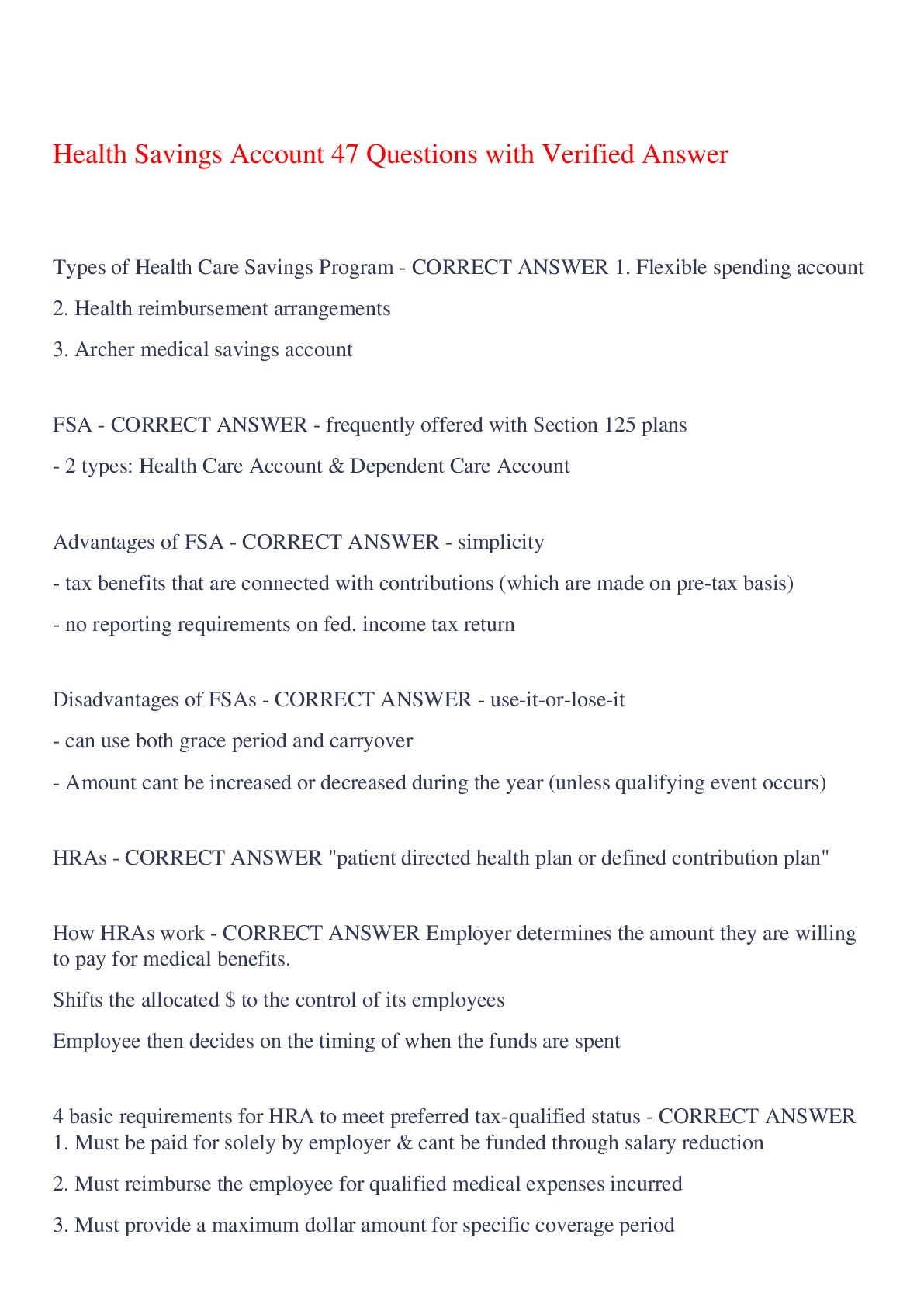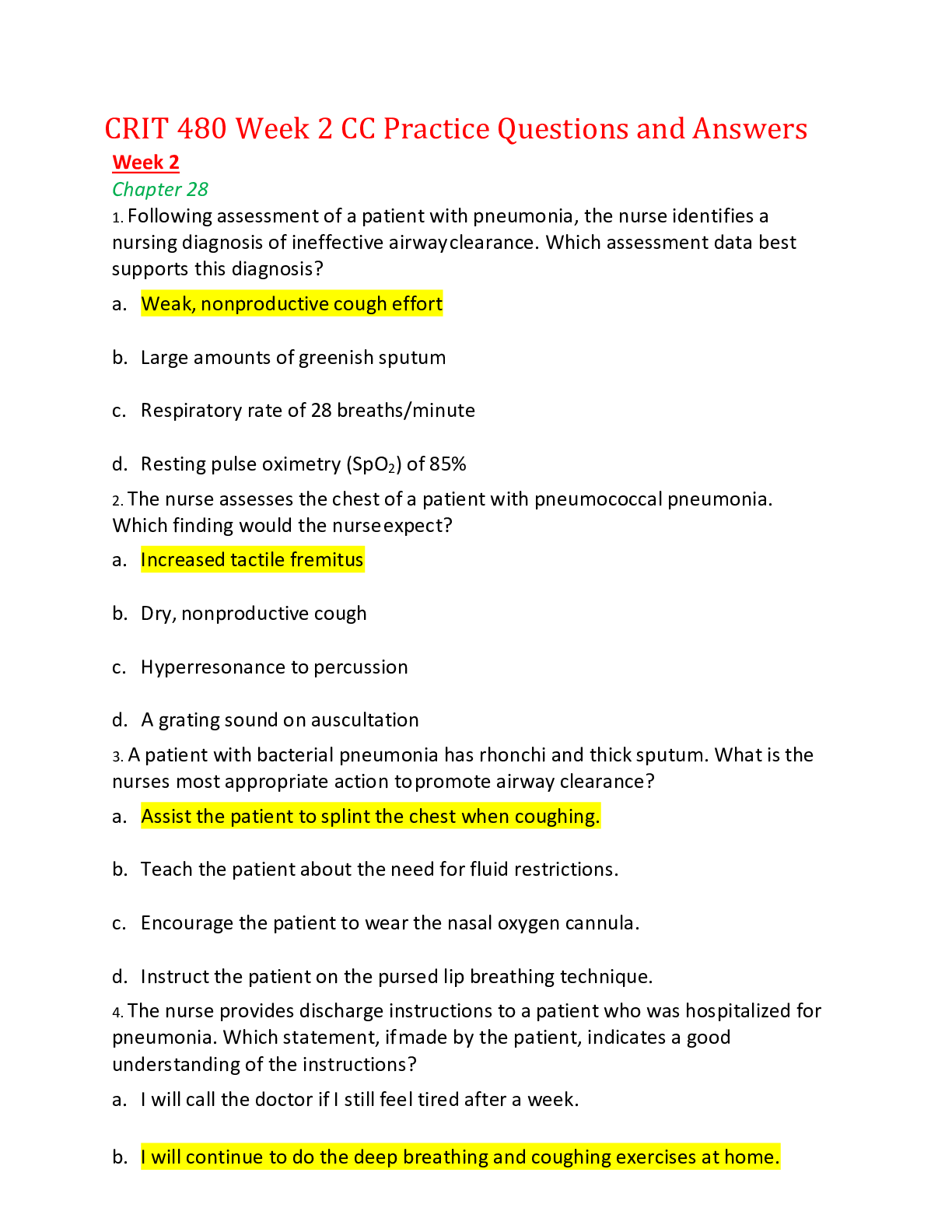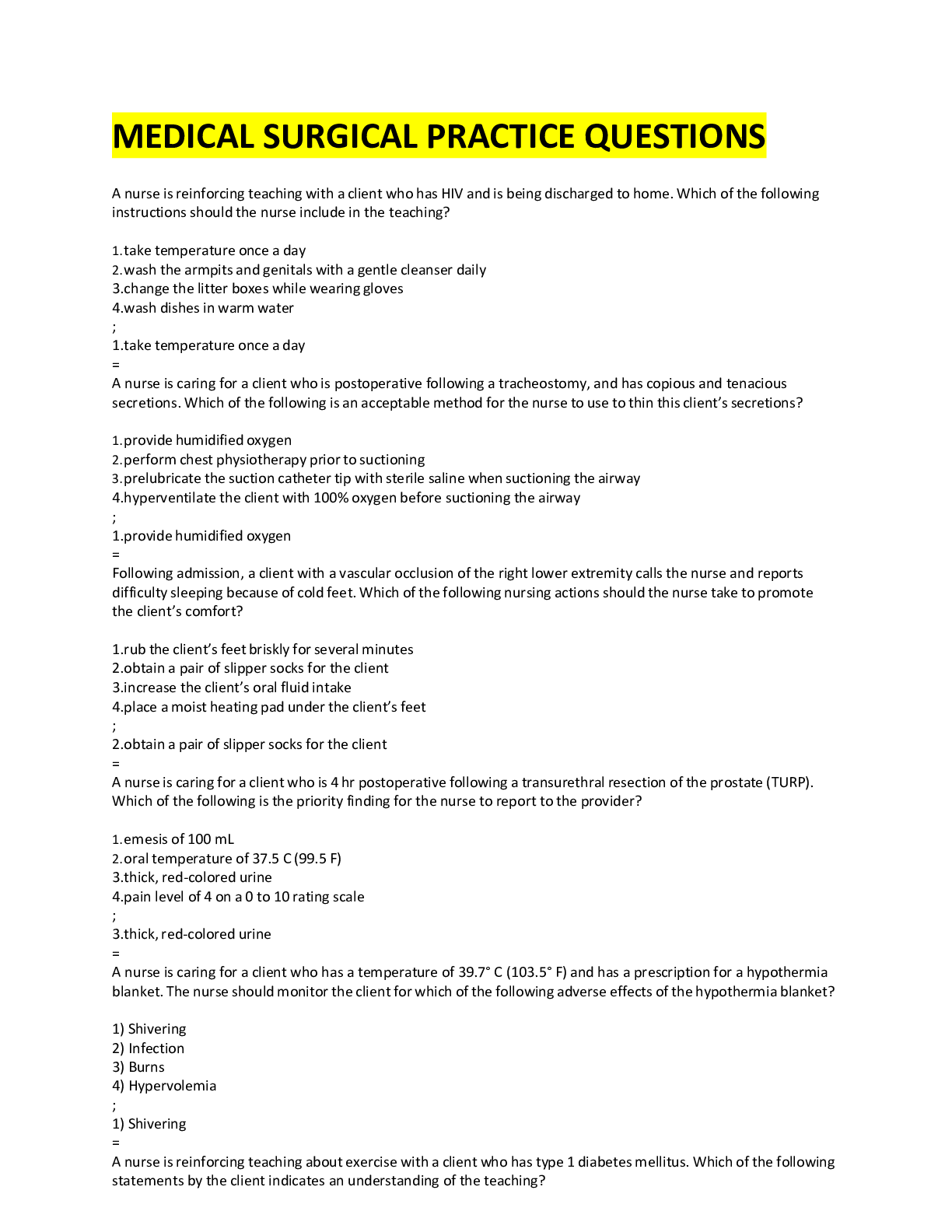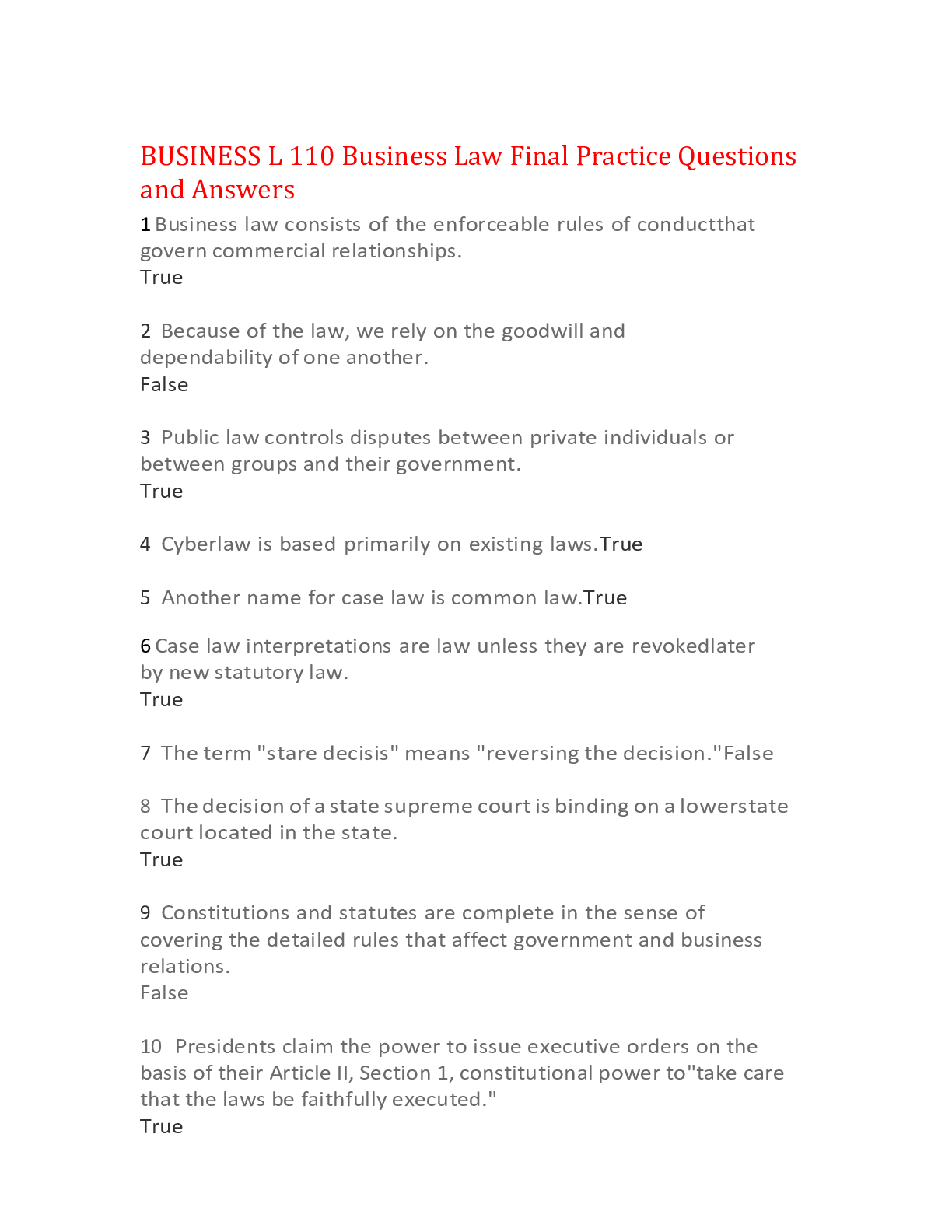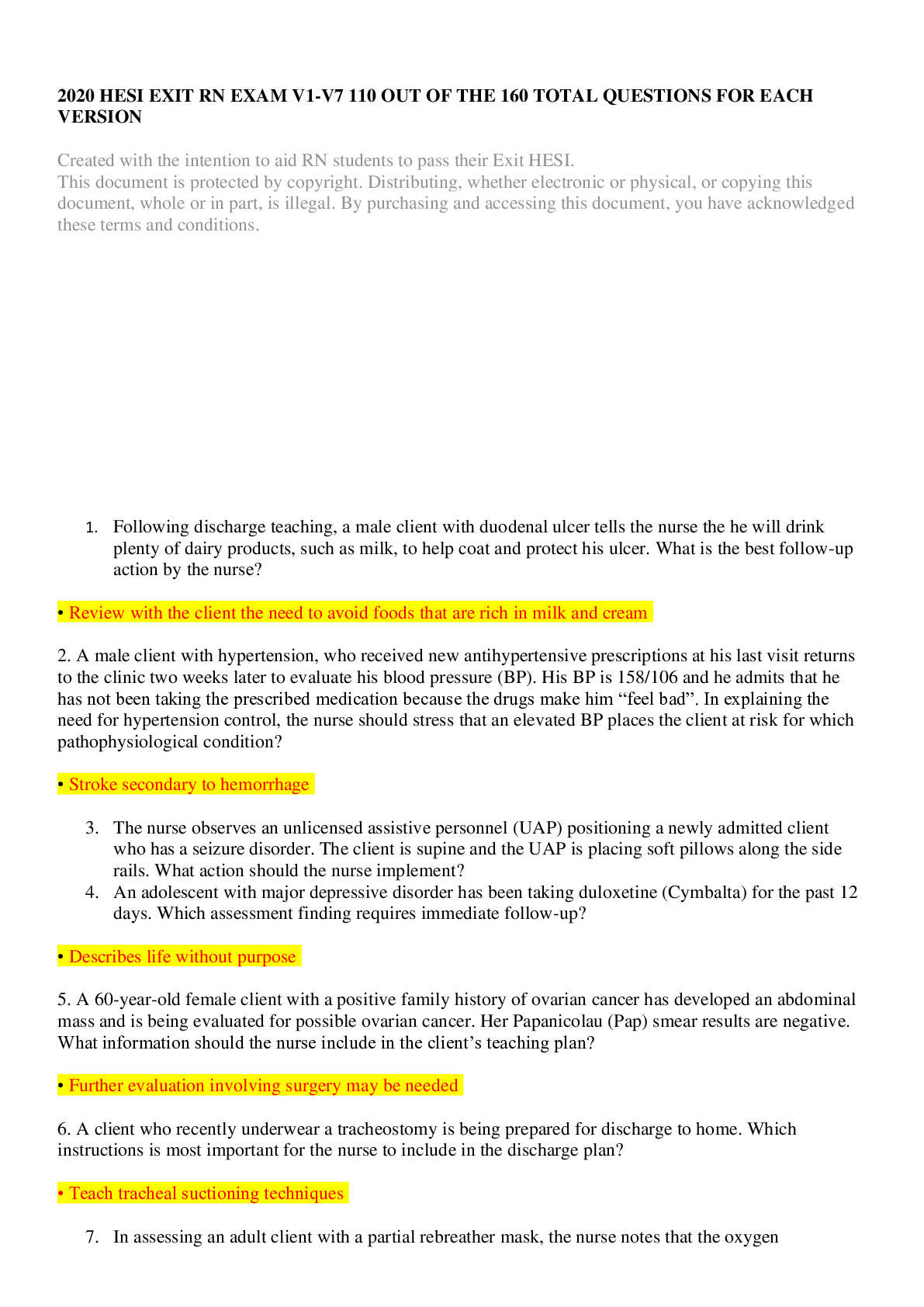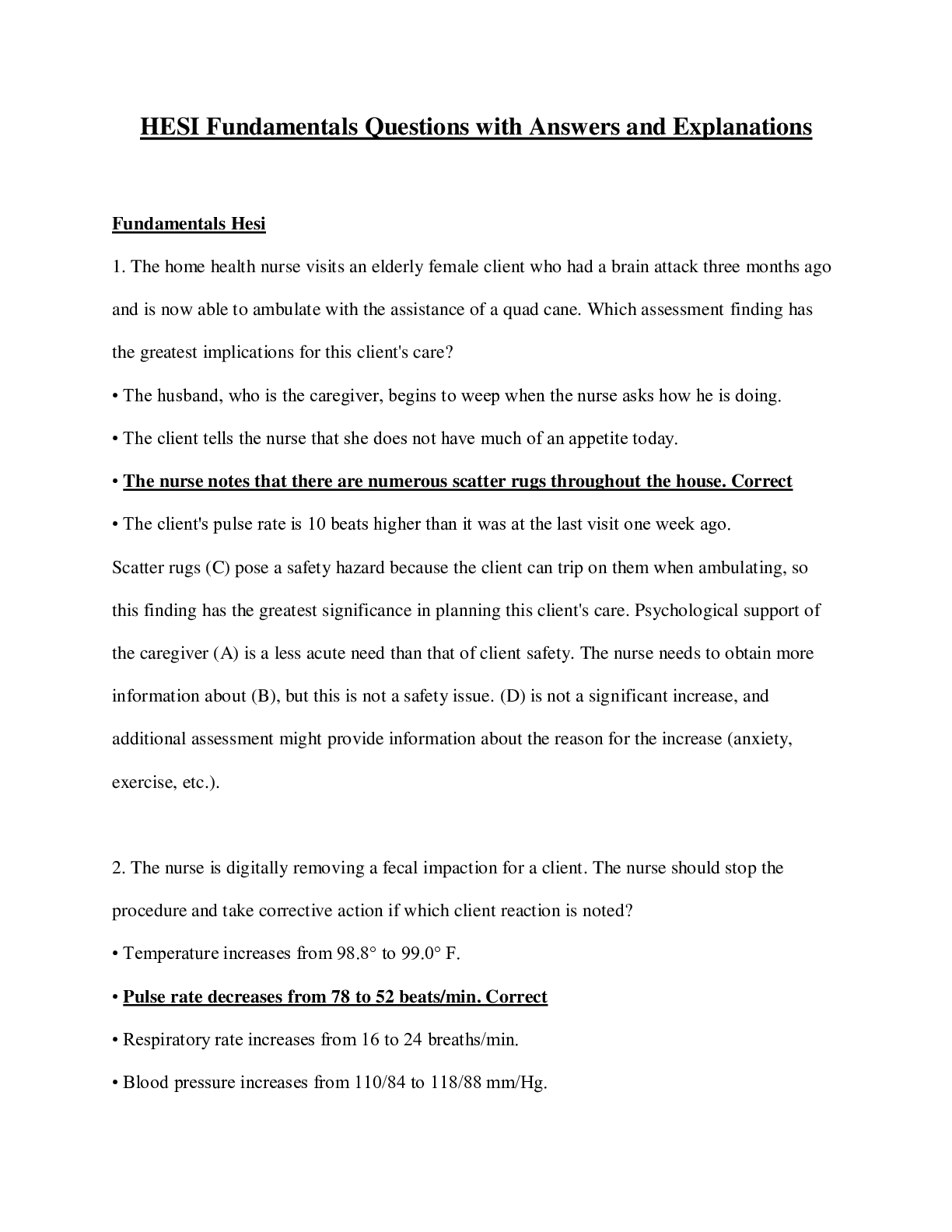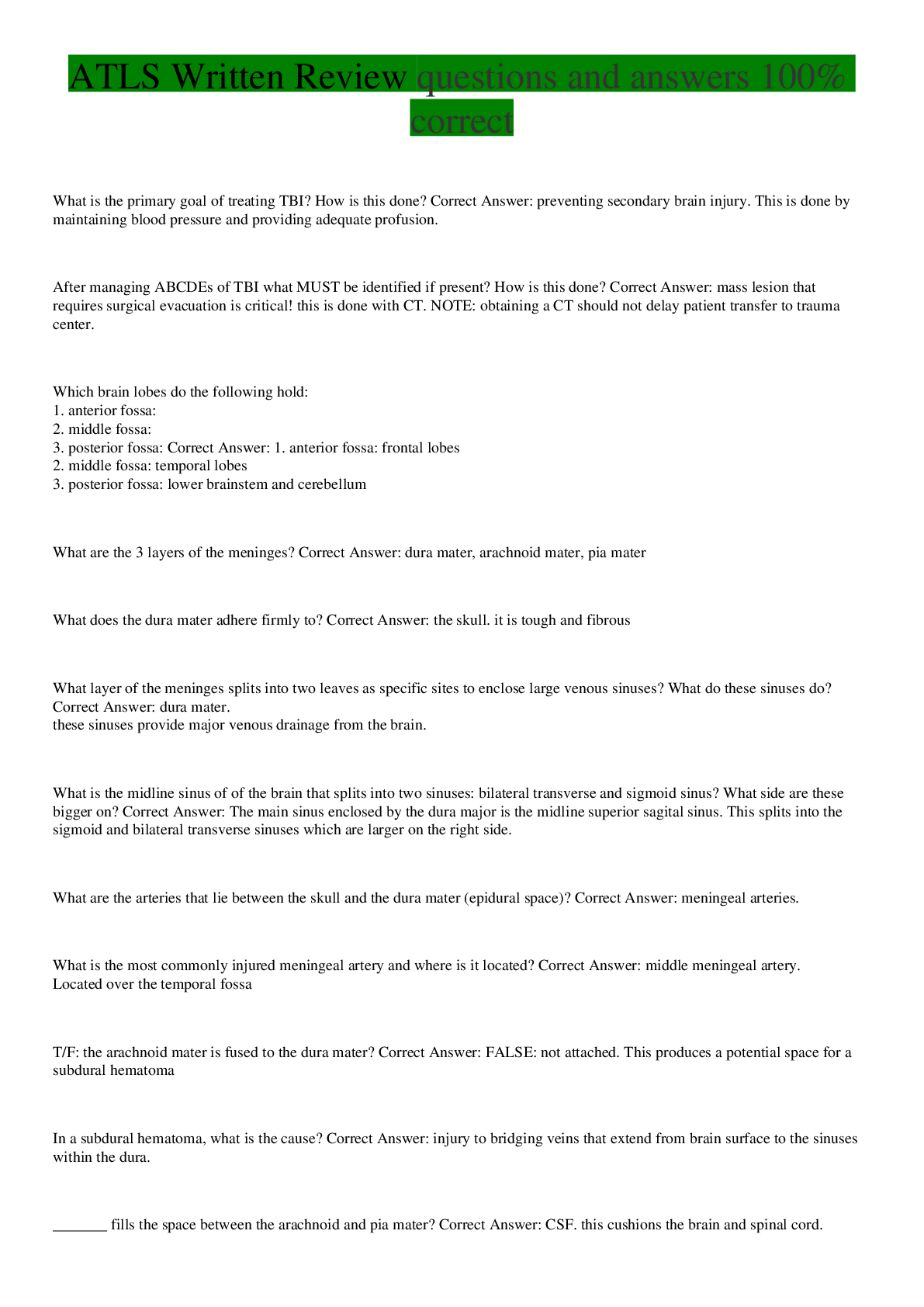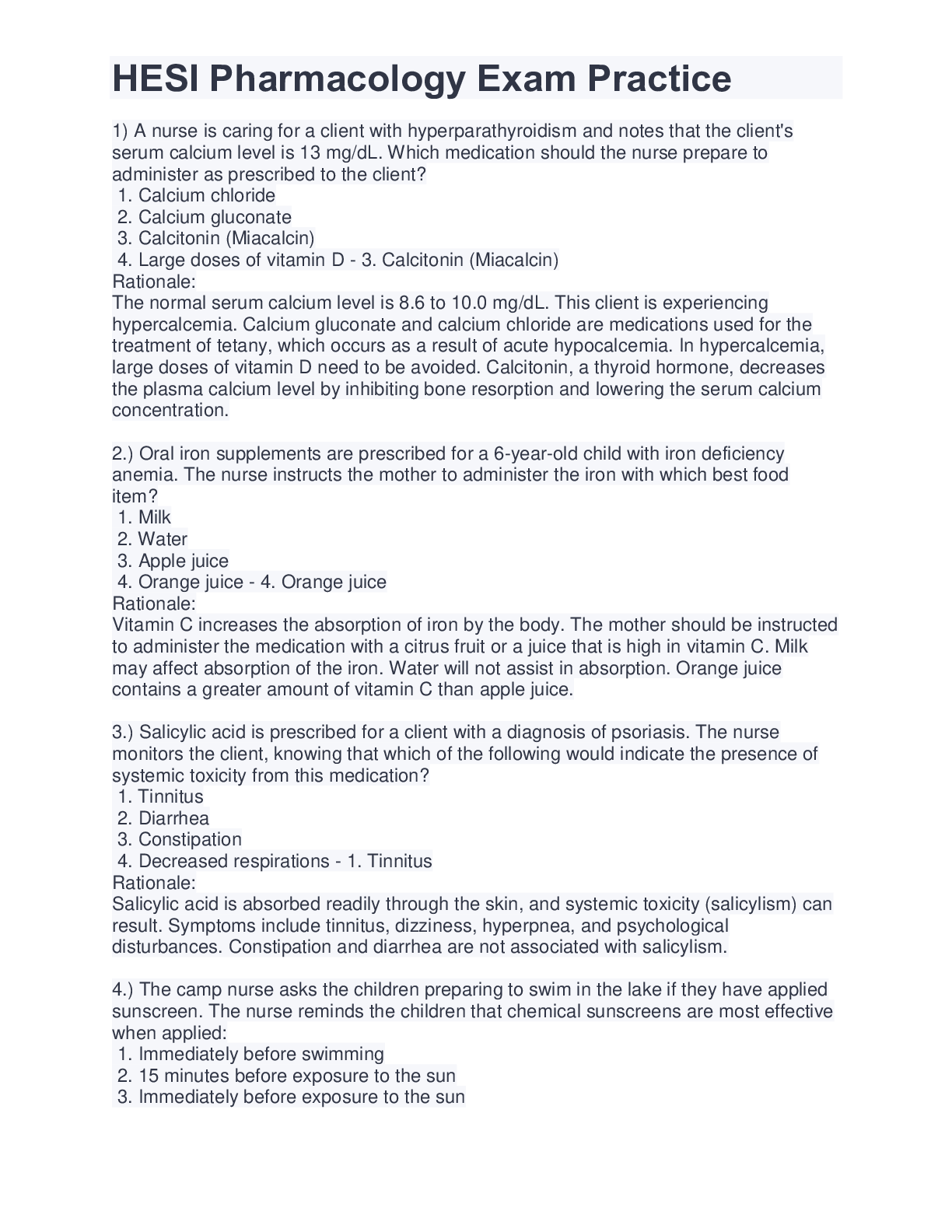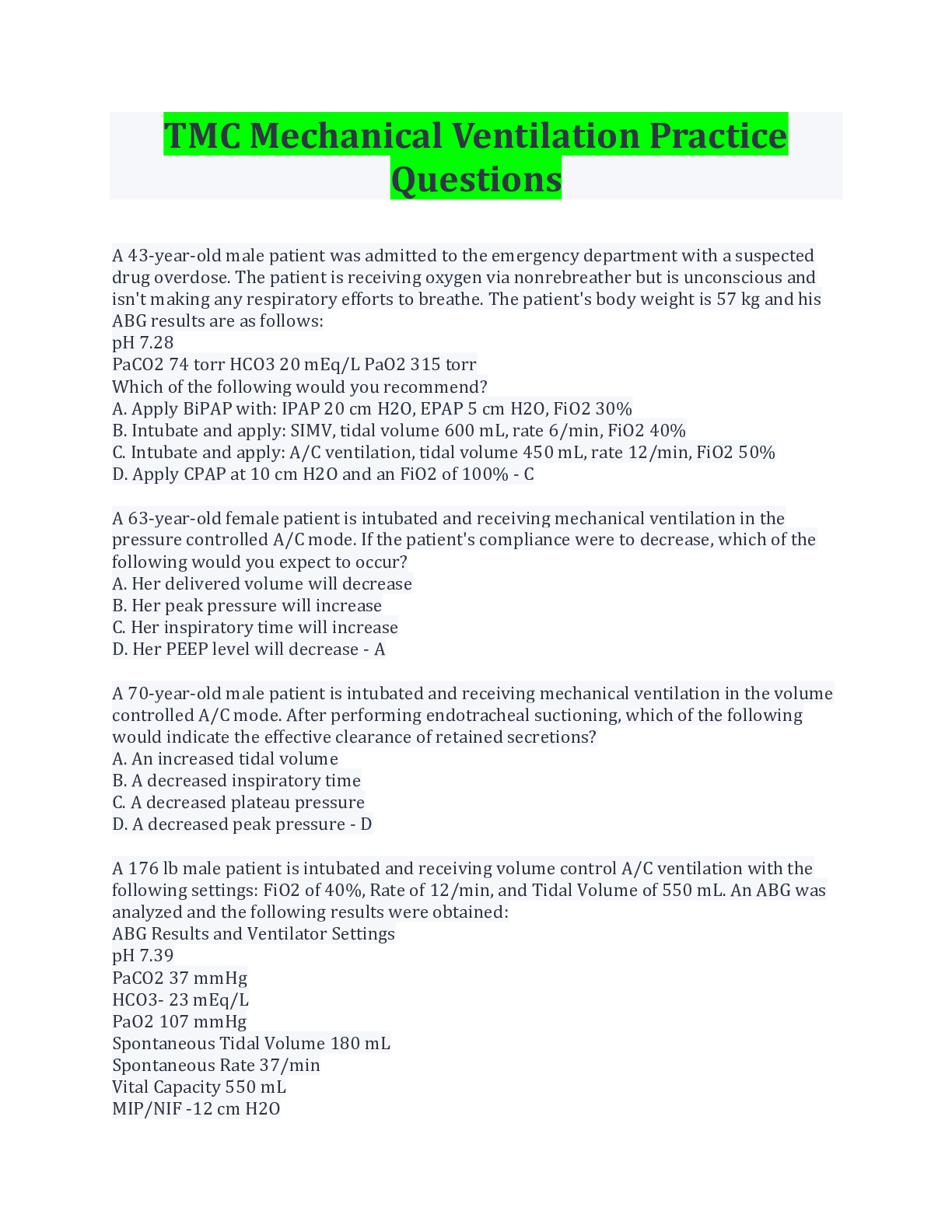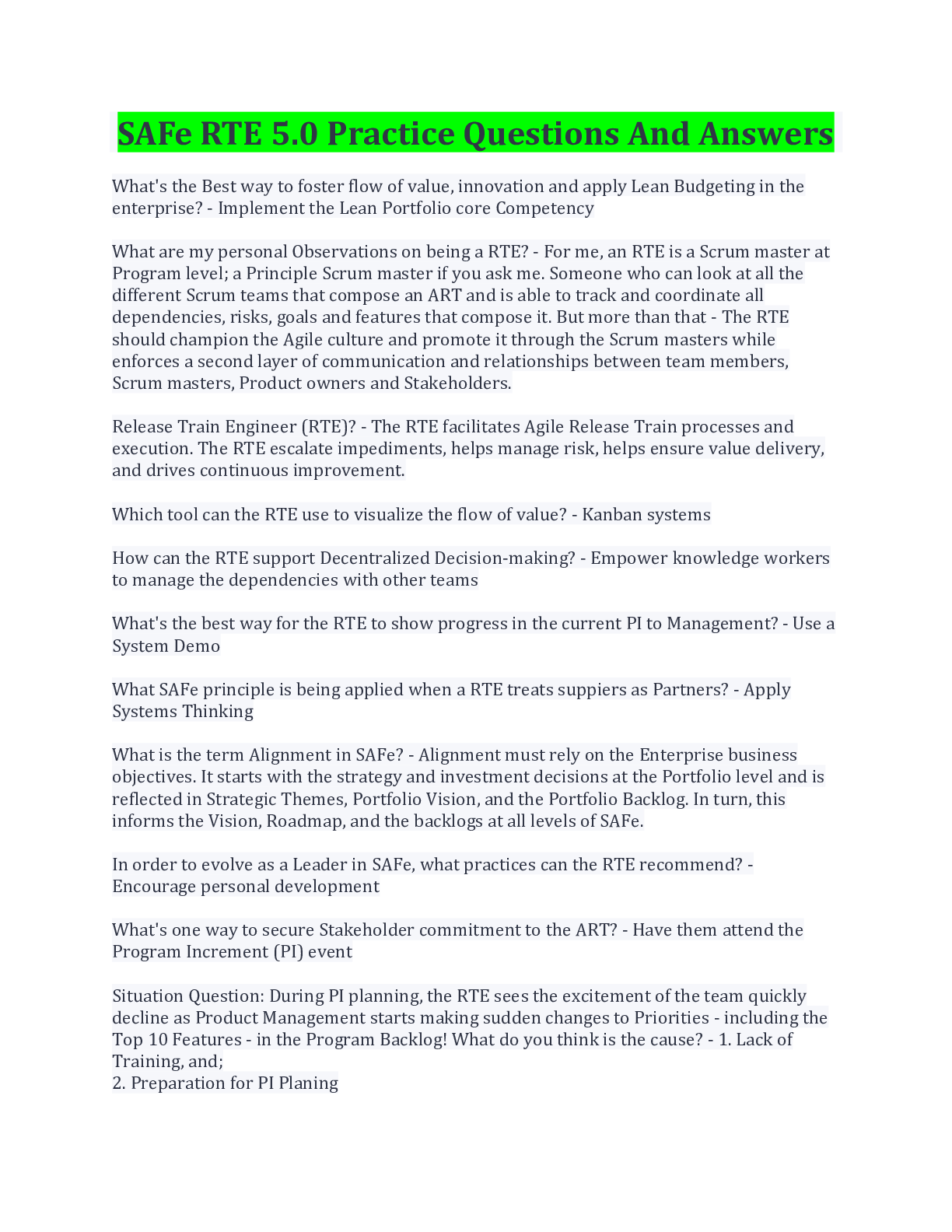CRIT 480/CC practice Questions and Answers week 1,100% CORRECT
Document Content and Description Below
CRIT 480/CC practice Questions and Answers week 1 Week 1 Chapter 66 1. A 68-year-old patient has been in the intensive care unit for 4 days and has a nursing diagnosis of disturbed sensory percepti... on related to sleep deprivation. Which action should the nurse include in the plan of care? a Administer prescribed sedatives or opioids at bedtime to promote sleep. . b Cluster nursing activities so that the patient has uninterrupted rest periods. . c. Silence the alarms on the cardiac monitors to allow 30- to 40-minute naps. d Eliminate assessments between 0100 and 0600 to allow uninterrupted sleep. . ANS: B 2. Which hemodynamic parameter is most appropriate for the nurse to monitor to determine the effectiveness of medications given to a patient to reduce left ventricular afterload? a Mean arterial pressure (MAP) . b Systemic vascular resistance (SVR) . c. Pulmonary vascular resistance (PVR) d Pulmonary artery wedge pressure (PAWP) . ANS: B 3. While family members are visiting, a patient has a respiratory arrest and is being resuscitated. Which action by the nurse is best? a Tell the family members that watching the resuscitation will be very stressful. . b Ask family members if they wish to remain in the room during the resuscitation. . c. Take the family members quickly out of the patient room and remain with them. d Assign a staff member to wait with family members just outside the patient room. . ANS: B 4. Following surgery for an abdominal aortic aneurysm, a patients central venous pressure (CVP) monitor indicates low pressures. Which action is a priority for the nurse to take? a Administer IV diuretic medications. . b Increase the IV fluid infusion per protocol. . c. Document the CVP and continue to monitor. d Elevate the head of the patients bed to 45 degrees. . ANS: B 5. When caring for a patient with pulmonary hypertension, which parameter is most appropriate for the nurse to monitor to evaluate the effectiveness of the treatment? a Central venous pressure (CVP) . b Systemic vascular resistance (SVR) . c. Pulmonary vascular resistance (PVR) d Pulmonary artery wedge pressure (PAWP) . ANS: C 6. The intensive care unit (ICU) nurse educator will determine that teaching about arterial pressure monitoring for a new staff nurse has been effective when the nurse a balances and calibrates the monitoring equipment every 2 hours. . b positions the zero-reference stopcock line level with the phlebostatic axis. . c. ensures that the patient is supine with the head of the bed flat for all readings. d rechecks the location of the phlebostatic axis when changing the patients position. . ANS: B 7. When monitoring for the effectiveness of treatment for a patient with a large anterior wall myocardial infarction, the most important information for the nurse to obtain is a central venous pressure (CVP). . b systemic vascular resistance (SVR). . c. pulmonary vascular resistance (PVR). d pulmonary artery wedge pressure (PAWP). . ANS: D 8. Which action is a priority for the nurse to take when the low pressure alarm sounds for a patient who has an arterial line in the left radial artery? a Fast flush the arterial line. . b Check the left hand for pallor. . c. Assess for cardiac dysrhythmias. d Rezero the monitoring equipment. . ANS: C 9. Which action will the nurse need to do when preparing to assist with the insertion of a pulmonary artery catheter? a Determine if the cardiac troponin level is elevated. . b Auscultate heart and breath sounds during insertion. . c. Place the patient on NPO status before the procedure. d Attach cardiac monitoring leads before the procedure. . ANS: D 10. When assisting with the placement of a pulmonary artery (PA) catheter, the nurse notes that the catheter is correctly placed when the monitor shows a a typical PA pressure waveform. . b tracing of the systemic arterial pressure. . c. tracing of the systemic vascular resistance. d typical PA wedge pressure (PAWP) tracing. . ANS: D 11. Which assessment finding obtained by the nurse when caring for a patient with a right radial arterial line indicates a need for the nurse to take immediate action? a The right hand is cooler than the lef t hand. . b The mean arterial pressure (MAP) is 77 mm Hg. . c. The system is delivering 3 mL of flush solution per hour. d The flush bag and tubing were last changed 3 days previously. . 12. The central venous oxygen saturation (ScvO2) is decreasing in a patient who has severe pancreatitis. To determine the possible cause of the decreased ScvO2, the nurse assesses the patients a lipase. . b temperature. . c. urinary output. d body mass index. . 13. An intraaortic balloon pump (IABP) is being used for a patient who is in cardiogenic shock. Which assessment data indicate to the nurse that the goals of treatment with the IABP are being met? a Urine output of 25 mL/hr . b Heart rate of 110 beats/minute . c. Cardiac output (CO) of 5 L/min d Stroke volume (SV) of 40 mL/beat . 14. The nurse is caring for a patient who has an intraaortic balloon pump in place. Which action should be included in the plan of care? a Position the patient supine at all times. . b Avoid the use of anticoagulant medications. . c. Measure the patients urinary output every hour. d Provide passive range of motion for all extremities. . 15. While waiting for cardiac transplantation, a patient with severe cardiomyopathy has a ventricular assist device (VAD) implanted. When planning care for this patient, the nurse should anticipate a giving immunosuppressive medications. . b preparing the patient for a permanent VAD. . c. teaching the patient the reason for complete bed rest. d monitoring the surgical incision for signs of infection. . 16. To verify the correct placement of an oral endotracheal tube (ET) after insertion, the best initial action by the nurse is to a auscultate for the presence of bilateral breath sounds. . b obtain a portable chest x-ray to check tube placement. . c. observe the chest for symmetric chest movement with ventilation. d use an end-tidal CO2 monitor to check for placement in the trachea. . 17. To maintain proper cuff pressure of an endotracheal tube (ET) when the patient is on mechanical ventilation, the nurse should a inflate the cuff with a minimum of 10 mL of air. . b inflate the cuff until the pilot balloon is firm on palpation. . c. inject air into the cuff until a manometer shows 15 mm Hg pressure. d inject air into the cuff until a slight leak is heard only at peak inflation. . 18. The nurse notes premature ventricular contractions (PVCs) while suctioning a patients endotracheal tube. Which action by the nurse is a priority? a Decrease the suction pressure to 80 mm Hg. . b Document the dysrhythmia in the patients chart. . c. Stop and ventilate the patient with 100% oxygen. d Give antidysrhythmic medications per protocol. . 19. Which assessment finding obtained by the nurse when caring for a patient receiving mechanical ventilation indicates the need for suctioning? a The patients oxygen saturation is 93%. . b The patient was last suctioned 6 hours ago. . c. The patients respiratory rate is 32 breaths/minute. d The patient has occasional audible expiratory wheezes. . 20. The nurse notes thick, white secretions in the endotracheal tube (ET) of a patient who is receiving mechanical ventilation. Which intervention will be most effective in addressing this problem? a Increase suctioning to every hour. . b Reposition the patient every 1 to 2 hours. . c. Add additional water to the patients enteral feedings. d Instill 5 mL of sterile saline into the ET before suctioning. . 21. Four hours after mechanical ventilation is initiated for a patient with chronic obstructive pulmonary disease (COPD), the patients arterial blood gas (ABG) results include a pH of 7.51, PaO2 of 82 mm Hg, PaCO2 of 26 mm Hg, and HCO3 of 23 mEq/L (23 mmol/L). The nurse will anticipate the need to a increase the FIO2. . b increase the tidal volume. . c. increase the respiratory rate. d decrease the respiratory rate. . 22. A patient with respiratory failure has arterial pressurebased cardiac output (APCO) monitoring and is receiving mechanical ventilation with peak end-expiratory pressure (PEEP) of 12 cm H2O. Which information indicates that a change in the ventilator settings may be required? a The arterial pressure is 90/46. . b The heart rate is 58 beats/minute. . c. The stroke volume is increased. d The stroke volume variation is 12%. . 23. A nurse is weaning a 68-kg male patient who has chronic obstructive pulmonary disease (COPD) from mechanical ventilation. Which patient assessment finding indicates that the weaning protocol should be stopped? a The patients heart rate is 97 beats/min. . b The patients oxygen saturation is 93%. . c. The patient respiratory rate is 32 breaths/min. d The patients spontaneous tidal volume is 450 mL. . 24. The nurse is caring for a patient receiving a continuous norepinephrine (Levophed) IV infusion. Which patient assessment finding indicates that the infusion rate may need to be adjusted? a Heart rate is 58 beats/minute. . b Mean arterial pressure (MAP) is 56 mm Hg. . c. Systemic vascular resistance (SVR) is elevated. d Pulmonary artery wedge pressure (PAWP) is low. . 25. When caring for the patient with a pulmonary artery (PA) pressure catheter, the nurse observes that the PA waveform indicates that the catheter is in the wedged position. Which action should the nurse take next? a Zero balance the transducer. . b Activate the fast flush system. . c. Notify the health care provider. d Deflate and reinflate the PA balloon. . 26. When evaluating a patient with a central venous catheter, the nurse observes that the insertion site is red and tender to touch and the patients temperature is 101.8 F. What should the nurse plan to do next? a Give analgesics and antibiotics as ordered. . b Discontinue the catheter and culture the tip. . c. Change the flush system and monitor the site. d Check the site more frequently for any swelling. . 27. An 81-year-old patient who has been in the intensive care unit (ICU) for a week is now stable and transfer to the progressive care unit is planned. On rounds, the nurse notices that the patient has new onset confusion. The nurse will plan to a give PRN lorazepam (Ativan) and cancel the transfer. . b inform the receiving nurse and then transfer the patient. . c. notify the health care provider and postpone the transfer. d obtain an order for restraints as needed and transfer the patient. . 28. The family members of a patient who has just been admitted to the intensive care unit (ICU) with multiple traumatic injuries have just arrived in the ICU waiting room. Which action should the nurse take next? a Explain ICU visitation policies and encourage family visits. . b Immediately take the family members to the patients bedside. . c. Describe the patients injuries and the care that is being provided. d Invite the family to participate in a multidisciplinary care conference. . 29. When caring for a patient who has an arterial catheter in the left radial artery for arterial pressurebased cardiac output (APCO) monitoring, which information obtained by the nurse is most important to report to the health care provider? a The patient has a positive Allen test. . b There is redness at the catheter insertion site. . c. The mean arterial pressure (MAP) is 86 mm Hg. d The dicrotic notch is visible in the arterial waveform. . 30. The nurse responds to a ventilator alarm and finds the patient lying in bed holding the endotracheal tube (ET). Which action should the nurse take next? a Activate the rapid response team. . b Provide reassurance to the patient. . c. Call the health care provider to reinsert the tube. d Manually ventilate the patient with 100% oxygen. . 31. The nurse notes that a patients endotracheal tube (ET), which was at the 22-cm mark, is now at the 25-cm mark and the patient is anxious and restless. Which action should the nurse take next? a Offer reassurance to the patient. . b Bag the patient at an FIO2 of 100%. . c. Listen to the patients breath sounds. d Notify the patients health care provider. . 32. The nurse educator is evaluating the care that a new registered nurse (RN) provides to a patient receiving mechanical ventilation. Which action by the new RN indicates the need for more education? a The RN increases the FIO2 to 100% before suctioning. . b The RN secures a bite block in place using adhesive tape. . c. The RN asks for assistance to reposition the endotracheal tube. d The RN positions the patient with the head of bed at 10 degrees. . 33. A patient who is orally intubated and receiving mechanical ventilation is anxious and is fighting the ventilator. Which action should the nurse take next? a Verbally coach the patient to breathe with the ventilator. . b Sedate the patient with the ordered PRN lorazepam (Ativan). . c. Manually ventilate the patient with a bag-valve-mask device. d Increase the rate for the ordered propofol (Diprivan) infusion. . 34. The nurse educator is evaluating the performance of a new registered nurse (RN) who is providing care to a patient who is receiving mechanical ventilation with 15 cm H2O of peak end-expiratory pressure (PEEP). Which action indicates that the new RN is safe? a The RN plans to suction the patient every 1 to 2 hours. . b The RN uses a closed-suction technique to suction the patient. . c. The RN tapes connection between the ventilator tubing and the ET. d The RN changes the ventilator circuit tubing routinely every 48 hours. . 35. The nurse is caring for a patient with a subarachnoid hemorrhage who is intubated and placed on a mechanical ventilator with 10 cm H2O of peak end-expiratory pressure (PEEP). When monitoring the patient, the nurse will need to notify the health care provider immediately if the patient develops a oxygen saturation of 93%. . b respirations of 20 breaths/minute. . c. green nasogastric tube drainage. d increased jugular venous distention. . 36. A patient who is receiving positive pressure ventilation is scheduled for a spontaneous breathing trial (SBT). Which finding by the nurse is most important to discuss with the health care provider before starting the SBT? a New ST segment elevation is noted on the cardiac monitor. . b Enteral feedings are being given through an orogastric tube. . c. Scattered rhonchi are heard when auscultating breath sounds. d HYDROmorphone (Dilaudid) is being used to treat postoperative pain. . 37. After change-of-shift report on a ventilator weaning unit, which patient should the nurse assess first? a Patient who failed a spontaneous breathing trial and has been placed in a rest mode on the . ventilator b Patient who is intubated and has continuous partial pressure end-tidal CO2 (PETCO2) monitoring . c. Patient with a central venous oxygen saturation (ScvO2) of 69% while on bilevel positive airway pressure (BiPAP) d Patient who was successfully weaned and extubated 4 hours ago and now has no urine output . for the last 6 hours 38. After change-of-shift report, which patient should the progressive care nurse assess first? a Patient who was extubated in the morning and has a temperature of 101.4 F (38.6 C) . b Patient with bilevel positive airway pressure (BiPAP) for sleep apnea whose respiratory rate is 16 . c. Patient with arterial pressure monitoring who is 2 hours postpercutaneous coronary intervention who needs to void d Patient who is receiving IV heparin for a venous thromboembolism and has a partial . thromboplastin time (PTT) of 98 sec 1. A patients vital signs are pulse 87, respirations 24, and BP of 128/64 mm Hg and cardiac output is 4.7 L/min. The patients stroke volume is mL. (Round to the nearest whole number.) ANS: 54 1. When assisting with oral intubation of a patient who is having respiratory distress, in which order will the nurse take these actions? (Put a comma and a space between each answer choice [A, B, C, D, E].) a. Obtain a portable chest-x-ray. b. Position the patient in the supine position. c. Inflate the cuff of the endotracheal tube after insertion. d. Attach an end-tidal CO2 detector to the endotracheal tube. e. Oxygenate the patient with a bag-valve-mask device for several minutes. ANS: E, B, C, D, A 2. The nurse is caring for a patient who has an intraortic balloon pump (IABP) following a massive heart attack. When assessing the patient, the nurse notices blood backing up into the IABP catheter. In which order should the nurse take the following actions? (Put a comma and a space between each answer choice [A, B, C, D].) a. Ensure that the IABP console has turned off. b. Assess the patients vital signs and orientation. c. Obtain supplies for insertion of a new IABP catheter. d. Notify the health care provider of the IABP malfunction. ANS: A, B, D, C Chapter 69 1. During the primary assessment of a victim of a motor vehicle collision, the nurse determines that the patient is breathing and has an unobstructed airway. Which action should the nurse take next? a Palpate extremities for bilateral pulses. . b Observe the patients respiratory effort. . c. Check the patients level of consciousness. d Examine the patient for any external bleeding. . 2. During the primary survey of a patient with severe leg trauma, the nurse observes that the patients left pedal pulse is absent and the leg is swollen. Which action will the nurse take next? a Send blood to the lab for a complete blood count. . b Assess further for a cause of the decreased circulation. . c. Finish the airway, breathing, circulation, disability survey. d Start normal saline fluid infusion with a large-bore IV line. . 3. After the return of spontaneous circulation following the resuscitation of a patient who had a cardiac arrest, therapeutic hypothermia is ordered. Which action will the nurse include in the plan of care? a Apply external cooling device. . b Check mental status every 15 minutes. . c. Avoid the use of sedative medications. d Rewarm if temperature is <91 F (32.8 C). . 4. A patient who is unconscious after a fall from a ladder is transported to the emergency department by emergency medical personnel. During the primary survey of the patient, the nurse should a obtain a complete set of vital signs. . b obtain a Glasgow Coma Scale score. . c. ask about chronic medical conditions. d attach a cardiac electrocardiogram monitor. . 5. A 19-year-old is brought to the emergency department (ED) with multiple lacerations and tissue avulsion of the left hand. When asked about tetanus immunization, the patient denies having any previous vaccinations. The nurse will anticipate giving a tetanus immunoglobulin (TIG) only. . b TIG and tetanus-diphtheria toxoid (Td). . c. tetanus-diphtheria toxoid and pertussis vaccine (Tdap) only. d TIG and tetanus-diphtheria toxoid and pertussis vaccine (Tdap). . 6. A patient who has experienced blunt abdominal trauma during a motor vehicle collision is complaining of increasing abdominal pain. The nurse will plan to teach the patient about the purpose of a peritoneal lavage. . b abdominal ultrasonography. . c. nasogastric (NG) tube placement. d magnetic resonance imaging (MRI). . 7. A patient with hypotension and an elevated temperature after working outside on a hot day is treated in the emergency department (ED). The nurse determines that discharge teaching has been effective when the patient makes which statement? a I will take salt tablets when I work outdoors in the summer. . b I should take acetaminophen (Tylenol) if I start to feel too warm. . c. I should drink sports drinks when working outside in hot weather. d I will move to a cool environment if I notice that I am feeling confused. . 8. A 22-year-old patient who experienced a near drowning accident in a local pool, but now is awake and breathing spontaneously, is admitted for observation. Which assessment will be most important for the nurse to take during the observation period? a Auscultate heart sounds. . b Palpate peripheral pulses. . c. Auscultate breath sounds. d Check pupil reaction to light. . 9. When planning the response to the potential use of smallpox as an agent of terrorism, the emergency department (ED) nurse manager will plan to obtain adequate quantities of a vaccine. . b atropine. . c. antibiotics. d whole blood. . 10. When rewarming a patient who arrived in the emergency department (ED) with a temperature of 87 F (30.6 C), which assessment indicates that the nurse should discontinue active rewarming? a The patient begins to shiver. . b The BP decreases to 86/42 mm Hg. . c. The patient develops atrial fibrillation. d The core temperature is 94 F (34.4 C). . 11. When assessing an older patient admitted to the emergency department (ED) with a broken arm and facial bruises, the nurse observes several additional bruises in various stages of healing. Which statement or question by the nurse is most appropriate? a Do you feel safe in your home? . b You should not return to your home. . c. Would you like to see a social worker? d I need to report my concerns to the police. . 12. A 20-year-old patient arrives in the emergency department (ED) several hours after taking 25 to 30 acetaminophen (Tylenol) tablets. Which action will the nurse plan to take? a Give N-acetylcysteine (Mucomyst). . b Discuss the use of chelation therapy. . c. Start oxygen using a non-rebreather mask. d Have the patient drink large amounts of water. . 13. A triage nurse in a busy emergency department (ED) assesses a patient who complains of 7/10 abdominal pain and states, I had a temperature of 103.9 F (39.9 C) at home. The nurses first action should be to a assess the patients current vital signs. . b give acetaminophen (Tylenol) per agency protocol. . c. ask the patient to provide a clean-catch urine for urinalysis. d tell the patient that it will 1 to 2 hours before being seen by the doctor. . 14. The emergency department (ED) triage nurse is assessing four victims involved in a motor vehicle collision. Which patient has the highest priority for treatment? a A patient with no pedal pulses. . b A patient with an open femur fracture. . c. A patient with bleeding facial lacerations. d A patient with paradoxic chest movements. . 15. The following interventions are part of the emergency department (ED) protocol for a patient who has been admitted with multiple bee stings to the hands. Which action should the nurse take first? a Remove the patients rings. . b Apply ice packs to both hands. . c. Apply calamine lotion to any itching areas. d Give diphenhydramine (Benadryl) 50 mg PO. . 16. Gastric lavage and administration of activated charcoal are ordered for an unconscious patient who has been admitted to the emergency department (ED) after ingesting 30 lorazepam (Ativan) tablets. Which action should the nurse plan to do first? a Insert a large-bore orogastric tube. . b Assist with intubation of the patient. . c. Prepare a 60-mL syringe with saline. d Give first dose of activated charcoal. . 17. A 54-year-old patient arrives in the emergency department (ED) after exposure to powdered lime at work. Which action should the nurse take first? a Obtain the patients vital signs. . b Obtain a baseline complete blood count. . c. Decontaminate the patient by showering with water. d Brush off any visible powder on the skin and clothing. . 18. An unresponsive 79-year-old is admitted to the emergency department (ED) during a summer heat wave. The patients core temperature is 105.4 F (40.8 C), blood pressure (BP) 88/50, and pulse 112. The nurse initiallywill plan to a apply wet sheets and a fan to the patient. . b provide O2 at 6 L/min with a nasal cannula. . c. start lactated Ringers solution at 1000 mL/hr. d give acetaminophen (Tylenol) rectal suppository. . 19. A patient is admitted to the emergency department (ED) after falling through the ice while ice skating. Which assessment will the nurse obtain first? a Heart rate . b Breath sounds . c. Body temperature d Level of consciousness . 20. Following an earthquake, patients are triaged by emergency medical personnel and are transported to the emergency department (ED). Which patient will the nurse need to assess first? a A patient with a red tag . b A patient with a blue tag . c. A patient with a black tag d A patient with a yellow tag . 21. Family members are in the patients room when the patient has a cardiac arrest and the staff start resuscitation measures. Which action should the nurse take next? a Keep the family in the room and assign a staff member to explain the care given and answer . questions. b Ask the family to wait outside the patients room with a designated staff member to provide . emotional support. c. Ask the family members about whether they would prefer to remain in the patients room or wait outside the room. d Tell the family members that patients are comforted by having family members present during . resuscitation efforts. 22. A 28-year-old patient who has deep human bite wounds on the left hand is being treated in the urgent care center. Which action will the nurse plan to take? a Prepare to administer rabies immune globulin (BayRab). . b Assist the health care provider with suturing of the bite wounds. . c. Teach the patient the reason for the use of prophylactic antibiotics. d Keep the wounds dry until the health care provider can assess them. . 23. The urgent care center protocol for tick bites includes the following actions. Which action will the nurse take first when caring for a patient with a tick bite? a Use tweezers to remove any remaining ticks. . b Check the vital signs, including temperature. . c. Give doxycycline (Vibramycin) 100 mg orally. d Obtain information about recent outdoor activities. . 1. When preparing to cool a patient who is to begin therapeutic hypothermia, which intervention will the nurse plan to do (select all that apply)? a Assist with endotracheal intubation. . b Insert an indwelling urinary catheter. . c. Begin continuous cardiac monitoring. d Obtain an order to restrain the patient. . e Prepare to give sympathomimetic drugs. . 2. The emergency department (ED) nurse is initiating therapeutic hypothermia in a patient who has been resuscitated after a cardiac arrest. Which actions in the hypothermia protocol can be delegated to an experienced licensed practical/vocational nurse (LPN/LVN) (select all that apply)? a Continuously monitor heart rhythm. . b Check neurologic status every 2 hours. . c. Place cooling blankets above and below patient. d Give acetaminophen (Tylenol) 650 mg per nasogastric tube. . e Insert rectal temperature probe and attach to cooling blanket control panel. . 1. The following four patients arrive in the emergency department (ED) after a motor vehicle collision. In which order should the nurse assess them? (Put a comma and a space between each answer choice [A, B, C, D, E].) a. A 74-year-old with palpitations and chest pain b. A 43-year-old complaining of 7/10 abdominal pain c. A 21-year-old with multiple fractures of the face and jaw d. A 37-year-old with a misaligned left leg with intact pulses ANS: C, A, B, D Chapter 1 1. The nurse completes an admission database and explains that the plan of care and discharge goals will be developed with the patients input. The patient states, How is this different from what the doctor does? Which response would be most appropriate for the nurse to make? a The role of the nurse is to administer medications and other treatments prescribed by your . doctor. b The nurses job is to help the doctor by collecting information and communicating any problems . that occur. c. Nurses perform many of the same procedures as the doctor, but nurses are with the patients for a longer time than the doctor. d In addition to caring for you while you are sick, the nurses will assist you to develop an . individualized plan to maintain your health. 2. The nurse describes to a student nurse how to use evidence-based practice guidelines when caring for patients. Which statement, if made by the nurse, would be the most accurate? a Inferences from clinical research studies are used as a guide. . b Patient care is based on clinical judgment, experience, and traditions. . c. Data are evaluated to show that the patient outcomes are consistently met. d Recommendations are based on research, clinical expertise, and patient preferences. . 3. The nurse teaches a student nurse about how to apply the nursing process when providing patient care. Which statement, if made by the student nurse, indicates that teaching was successful? a The nursing process is a scientific-based method of diagnosing the patients health care . problems. b The nursing process is a problem-solving tool used to identify and treat patients health care . needs. c. The nursing process is based on nursing theory that incorporates the biopsychosocial nature of humans. d The nursing process is used primarily to explain nursing interventions to other health care . professionals. 4. A patient has been admitted to the hospital for surgery and tells the nurse, I do not feel comfortable leaving my children with my parents. Which action should the nurse take next? a Reassure the patient that these feelings are common for parents. . b Have the patient call the children to ensure that they are doing well. . c. Gather more data about the patients feelings about the child-care arrangements. d Call the patients parents to determine whether adequate child care is being provided. . 5. A patient who is paralyzed on the left side of the body after a stroke develops a pressure ulcer on the left hip. Which nursing diagnosis is most appropriate? a Impaired physical mobility related to left-sided paralysis . b Risk for impaired tissue integrity related to left-sided weakness . c. Impaired skin integrity related to altered circulation and pressure d Ineffective tissue perfusion related to inability to move independently . 6. A patient with a bacterial infection has a nursing diagnosis of deficient fluid volume related to excessive diaphoresis. Which outcome would the nurse recognize as most appropriate for this patient? a Patient has a balanced intake and output. . b Patients bedding is changed when it becomes damp. . c. Patient understands the need for increased fluid intake. d Patients skin remains cool and dry throughout hospitalization. . 7. A nurse asks the patient if pain was relieved after receiving medication. What is the purpose of the evaluation phase of the nursing process? a To determine if interventions have been effective in meeting patient outcomes . b To document the nursing care plan in the progress notes of the medical record . c. To decide whether the patients health problems have been completely resolved d To establish if the patient agrees that the nursing care provided was satisfactory . 8. The nurse interviews a patient while completing the health history and physical examination. What is the purpose of the assessment phase of the nursing process? a To teach interventions that relieve health problems . b To use patient data to evaluate patient care outcomes . c. To obtain data with which to diagnose patient problems d To help the patient identify realistic outcomes for health problems . 9. Which nursing diagnosis statement is written correctly? a Altered tissue perfusion related to heart failure . b Risk for impaired tissue integrity related to sacral redness . c. Ineffective coping related to response to biopsy test results d Altered urinary elimination related to urinary tract infection . 10. The nurse admits a patient to the hospital and develops a plan of care. What components should the nurse include in the nursing diagnosis statement? a The problem and the suggested patient goals or outcomes . b The problem with possible causes and the planned interventions . c. The problem, its cause, and objective data that support the problem d The problem with an etiology and the signs and symptoms of the problem . 11. A nurse is caring for a patient with heart failure. Which task is appropriate for the nurse to delegate to experienced unlicensed assistive personnel (UAP)? a Monitor for shortness of breath or fatigue after ambulation. . b Instruct the patient about the need to alternate activity and rest. . c. Obtain the patients blood pressure and pulse rate after ambulation. d Determine whether the patient is ready to increase the activity level. . 12. A nurse is caring for a group of patients on the medical-surgical unit with the help of one float registered nurse (RN), one unlicensed assistive personnel (UAP), and one licensed practical/vocational nurse (LPN/LVN). Which assignment, if delegated by the nurse, would be inappropriate? a Measurement of a patients urine output by UAP . b Administration of oral medications by LPN/LVN . c. Check for the presence of bowel sounds and flatulence by UAP d Care of a patient with diabetes by RN who usually works on the pediatric unit . 13. Which task is appropriate for the nurse to delegate to a licensed practical/vocational nurse (LPN/LVN)? a Complete the initial admission assessment and plan of care. . b Document teaching completed before a diagnostic procedure. . c. Instruct a patient about low-fat, reduced sodium dietary restrictions. d Obtain bedside blood glucose on a patient before insulin administration. . 14. A nurse is assigned as a case manager for a hospitalized patient with a spinal cord injury. The patient can expect the nurse functioning in this role to perform which activity? a Care for the patient during hospitalization for the injuries. . b Assist the patient with home care activities during recovery. . c. Determine what medical care the patient needs for optimal rehabilitation. d Coordinate the services that the patient receives in the hospital and at home. . 15. The nurse is caring for an older adult patient who had surgery to repair a fractured hip. The patient needs continued nursing care and physical therapy to improve mobility before returning home. The nurse will help to arrange for transfer of this patient to which facility? a A skilled care facility . b A residential care facility . c. A transitional care facility d An intermediate care facility . 16. A home care nurse is planning care for a patient who has just been diagnosed with type 2 diabetes mellitus. Which task is appropriate for the nurse to delegate to the home health aide? a Assist the patient to choose appropriate foods. . b Help the patient with a daily bath and oral care. . c. Check the patients feet for signs of breakdown. d Teach the patient how to monitor blood glucose. . 17. The nurse is providing education to nursing staff on quality care initiatives. Which statement would be the most accurate description of the impact of health care financing on quality care? a Hospitals are reimbursed for all costs incurred if care is documented electronically. . b Payment for patient care is primarily based on clinical outcomes and patient satisfaction. . c. If a patient develops a catheter-related infection, the hospital receives additional funding. d Because hospitals are accountable for overall care, it is not nursings responsibility to monitor . care delivered by others. 18. The nurse documenting the patients progress in the care plan in the electronic health record before an interdisciplinary discharge conference is demonstrating competency in which QSEN category? a Patient-centered care . b Quality improvement . c. Evidence-based practice d Informatics and technology . 1. Which information will the nurse consider when deciding what nursing actions to delegate to a licensed practical/vocational nurse (LPN/LVN) who is working on a medical-surgical unit (select all that apply)? a Institutional policies . b Stability of the patient . c. State nurse practice act d LPN/LVN teaching abilities . e Experience of the LPN/LVN . 2. The nurse is administering medications to a patient. Which actions by the nurse during this process are consistent with promoting safe delivery of care (select all that apply)? a Throws away a medication that is not labeled . b Uses a hand sanitizer before preparing a medication . c. Identifies the patient by the room number on the door d Checks lab test results before administering a diuretic . e Gives the patient a list of current medications upon discharge . 1. The nurse uses the Situation-Background-Assessment-Recommendation (SBAR) format to communicate a change in patient status to a health care provider. In which order should the nurse make the following statements? (Put a comma and a space between each answer choice [A, B, C, D].) a. The patient needs to be evaluated immediately and may need intubation and mechanical ventilation. b. The patient was admitted yesterday with heart failure and has been receiving furosemide (Lasix) for diuresis, but urine output has been low. c. The patient has crackles audible throughout the posterior chest and the most recent oxygen saturation is 89%. Her condition is very unstable. d. This is the nurse on the surgical unit. After assessing the patient, I am very concerned about increased shortness of breath over the past hour. ANS: D, B, C, A Chapter 10 1. The nurse cares for a terminally ill patient who has 20-second periods of apnea followed by periods of deep and rapid breathing. Which action by the nurse would be most appropriate? a Suction the patient. . b Administer oxygen via face mask. . c. Place the patient in high Fowlers position. d Document the respirations as Cheyne-Stokes. . 2. The nurse cares for an adolescent patient who is dying. The patients parents are interested in organ donation and ask the nurse how the decision about brain death is made. Which response by the nurse is most appropriate? a Brain death occurs if a person is flaccid and unresponsive. . b If CPR is ineffective in restoring a heartbeat, the brain cannot function. . c. Brain death has occurred if there is no breathing and certain reflexes are absent. d If respiratory efforts cease and no apical pulse is audible, brain death is present. . 3. A hospice patient is manifesting a decrease in all body system functions except for a heart rate of 124 and a respiratory rate of 28. Which statement, if made by the nurse to the patients family member, is most appropriate? a These symptoms will continue to increase until death finally occurs. . b These symptoms are a normal response before these functions decrease. . c. These symptoms indicate a reflex response to the slowing of other body systems. d These symptoms may be associated with an improvement in the patients condition. . 4. A patient who has been diagnosed with inoperable lung cancer and has a poor prognosis plans a trip across the country to settle some issues with sisters and brothers. The nurse recognizes that the patient is manifesting which psychosocial response to death? a Restlessness . b Yearning and protest . c. Anxiety about unfinished business d Fear of the meaninglessness of ones life . 5. The spouse of a patient with terminal cancer visits daily and cheerfully talks with the patient about wedding anniversary plans for the next year. When the nurse asks about any concerns, the spouse says, Im busy at work, but otherwise things are fine. Which nursing diagnosis is most appropriate? a Ineffective coping related to lack of grieving . b Anxiety related to complicated grieving process . c. Caregiver role strain related to feeling overwhelmed d Hopelessness related to knowledge deficit about cancer . 6. As the nurse admits a patient in end-stage kidney disease to the hospital, the patient tells the nurse, If my heart or breathing stop, I do not want to be resuscitated. Which action is best for the nurse to take? a Ask if these wishes have been discussed with the health care provider. . b Place a Do Not Resuscitate (DNR) notation in the patients care plan. . c. Inform the patient that a notarized advance directive must be included in the record or resuscitation must be performed. d Advise the patient to designate a person to make health care decisions when the patient is not . able to make them independently. 7. A young adult patient with metastatic cancer, who is very close to death, appears restless. The patient keeps repeating, I am not ready to die. Which action is best for the nurse to take? a Remind the patient that no one feels ready for death. . b Sit at the bedside and ask if there is anything the patient needs. . c. Insist that family members remain at the bedside with the patient. d Tell the patient that everything possible is being done to delay death. . 8. The nurse cares for a terminally ill patient who is experiencing pain that is continuous and severe. How should the nurse schedule the administration of opioid pain medications? a Give around-the-clock routine administration of analgesics. . b Provide PRN doses of medication whenever the patient requests. . c. Offer enough pain medication to keep the patient sedated and unaware of stimuli. d Suggest analgesic doses that provide pain control without decreasing respiratory rate. . 9. The nurse cares for a patient with lung cancer in a home hospice program. Which action by the nurse is most appropriate? a Discuss cancer risk factors and appropriate lifestyle modifications. . b Encourage the patient to discuss past life events and their meaning. . c. Teach the patient about the purpose of chemotherapy and radiation. d Accomplish a thorough head-to-toe assessment several times a week. . 10. A hospice nurse who has become close to a terminally ill patient is present in the home when the patient dies and feels saddened and tearful as the family members begin to cry. Which action should the nurse take at this time? a Contact a grief counselor as soon as possible. . b Cry along with the patients family members. . c. Leave the home as soon as possible to allow the family to grieve privately. d Consider whether working in hospice is desirable because patient losses are common. . 11. A middle-aged patient tells the nurse, My mother died 4 months ago, and I just cant seem to get over it. Im not sure it is normal to still think about her every day. Which nursing diagnosis is most appropriate? a Hopelessness related to inability to resolve grief . b Complicated grieving related to unresolved issues . c. Anxiety related to lack of knowledge about normal grieving d Chronic sorrow related to ongoing distress about loss of mother . 12. The son of a dying patient tells the nurse, Mother doesnt really respond any more when I visit. I dont think she knows that I am here. Which response by the nurse is appropriate? a You may need to cut back your visits for now to avoid overtiring your mother. . b Withdrawal may sometimes be a normal response when preparing to leave life. . c. It will be important for you to stimulate your mother as she gets closer to dying. d Many patients dont really know what is going on around them at the end of life. . 13. Which patient should the nurse refer for hospice care? a 60-year-old with lymphoma whose children are unable to discuss issues related to dying . b 72-year-old with chronic severe pain as a result of spinal arthritis and vertebral collapse . c. 28-year-old with AIDS-related dementia who needs palliative care and pain management d 56-year-old with advanced liver failure whose family members can no longer provide care in the . home 14. The nurse admits a terminally ill patient to the hospital. What is the first action that the nurse should complete when planning this patients care? a Determine the patients wishes regarding end-of-life care. . b Emphasize the importance of addressing any family issues. . c. Discuss the normal grief process with the patient and family. d Encourage the patient to talk about any fears or unresolved issues. . 15. Which action is best for the nurse to take to ensure culturally competent care for an alert, terminally ill Filipino patient? a Ask the patient and family about their preferences for care during this time. . b Let the family decide whether to tell the patient about the terminal diagnosis. . c. Obtain information from Filipino staff members about possible cultural needs. d Remind family members that dying patients prefer to have someone at the bedside. . 1. Which nursing actions for the care of a dying patient can the nurse delegate to a licensed practical/vocational nurse (LPN/LVN) (select all that apply)? a Provide postmortem care to the patient. . b Encourage the family members to talk with and reassure the patient. . c. Determine how frequently physical assessments are needed for the patient. d Teach family members about commonly occurring signs of approaching death. . e Administer the prescribed morphine sulfate sublingual as necessary for pain control. . [Show More]
Last updated: 1 year ago
Preview 1 out of 51 pages
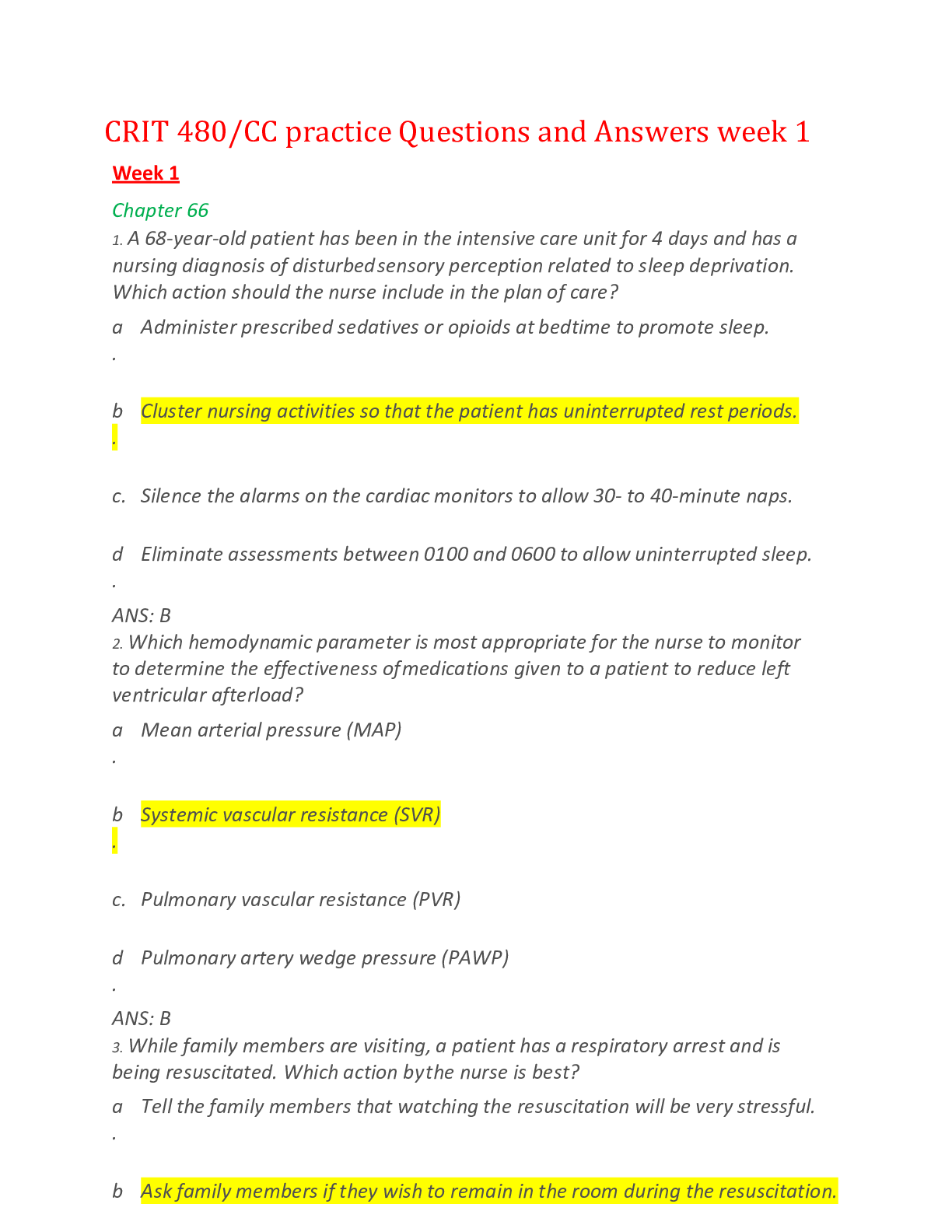
Reviews( 0 )
Document information
Connected school, study & course
About the document
Uploaded On
Jan 05, 2022
Number of pages
51
Written in
Additional information
This document has been written for:
Uploaded
Jan 05, 2022
Downloads
0
Views
49













